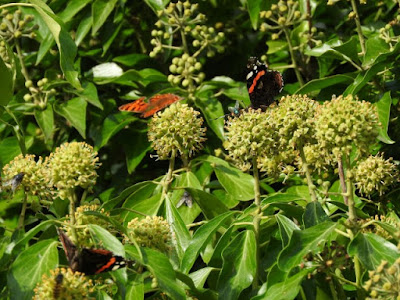For a few weeks in September and October, and sometimes as late as early November, ivy comes into flower. Mix sunshine, shelter, golden-yellow, pollen-rich flowers and a heady scent and you have an irresistible insect magnet. Ivy flowers in the sunshine quite literally hum with life.
In my garden what initially attracted me to look more closely at the feet deep ivy that adorns, and possible holds up, one old wall were the butterflies. Not quite clouds of butterflies but still the best show of red admirals and commas I have seen this year and with them a couple of painted ladies which seem to have been in short supply this summer.
Ivy flowers seem irresistible to commas and red admirals but look more closely and the flowers are busy with many smaller insect visitors, which like the larger butterflies are drawn here by a rich autumn bonanza of pollen and nectar.
Like many people interested in wildlife I can readily recognise most butterflies, some dragonflies and a few beetles. But that’s about it! With apologies to better entomologists here is my beginners’ guide to insects visiting ivy flowers.
 |
| Comma butterfly |
- Butterflies –
let’s start with the easy group and at least in my garden it’s red admirals, commas and painted ladies that can’t resist an ivy feast.
- Honey bees –
strangely bumblebees seem largely to ignore the ivy but honeybees delight in its yellow pollen and that’s the clue to recognise them. If it’s bee-like and flying away with a load of pollen attached to its leg it’s a honeybee. The proper name for this area on the bee’s leg is pollen basket.
- Wasps –
most of us can recognise a wasp and for good reason! But they are useful pollinators too and can’t resist the ivy. Strangely though they seem to spend most of their time cruising up and down and rarely settle on a flower. Any explanations?
- Ladybirds –
perhaps our best known group of beetles! The ladybirds on my garden ivy were all harlequins and they did seem to be feeding on the pollen. Do other ladybirds do this?
- Hoverflies –
this is where it gets tricky as there are many kinds of hoverflies and some species are really good mimics of honeybees, wasps or even hornets. Unlike bee,s hoverflies have short antennae, broad waists and massive eyes. They also, like other flies, have just a single pair of wings unlike bees which have two pairs. Not a lot of help though as try counting wings when these insects are in flight. Impossible!
- Flies – my final group which may not be terribly good taxonomy but you know what I mean. My garden ivy attracted flies galore. Some with green metallic bodies (greenbottles?), others which most of us might call house flies and some larger ones with brown on the wings. If you are a fly expert do comment and tell me the species. But look closer and there are myriads of much, much smaller flies. This is where I just step back and wonder at the sheer diversity of insects which share our world and our gardens.
Why not do your own ivy watch this autumn and see if my observations tally with your own. All you need is a sunny day, a few minutes of time, and a patch of old ivy decked in sunny golden globes.
Enjoy your autumn insect watch!





hi, im not sure if any one is interested, but i saw and captued a clip of a humming moth in my garden in pe14 wisbech area on the 27.9.16, i believe this is rare. keribygrave@gmail.com
ReplyDeleteThanks for this, I'll look forward to seeing the butterflies again but not so much the wasps!
ReplyDelete